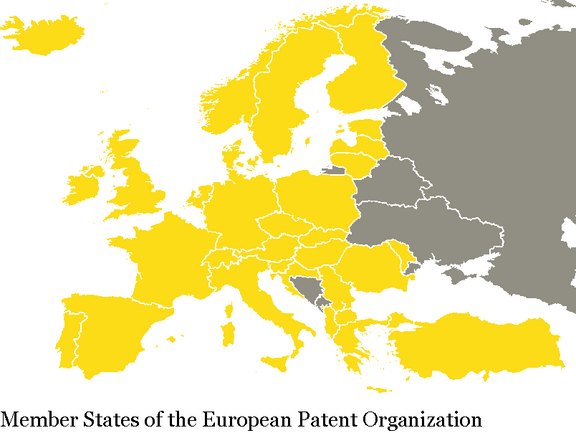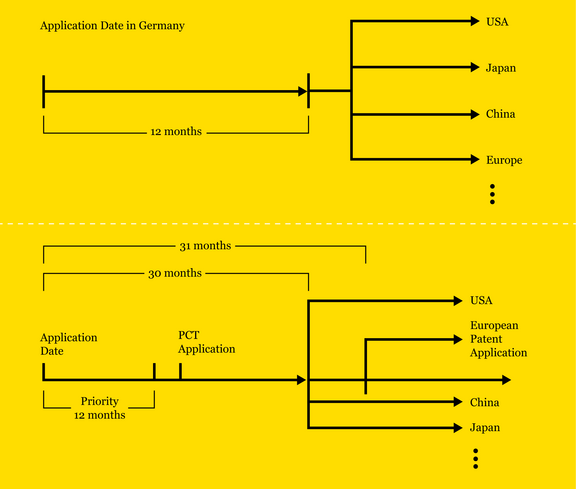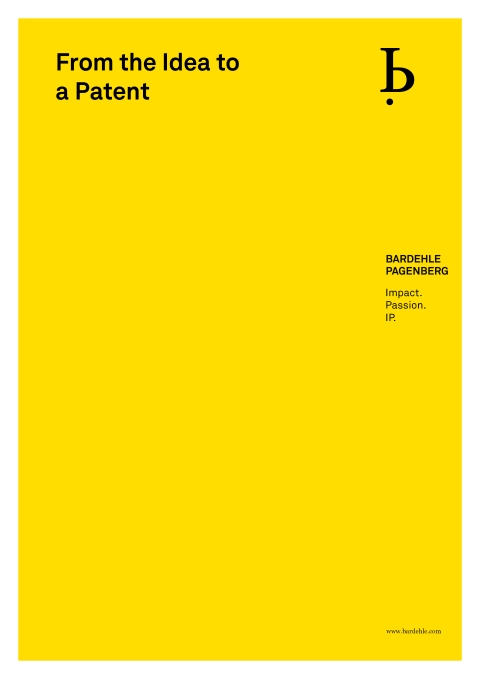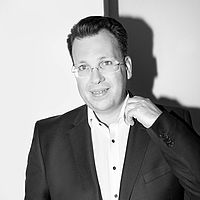From the Idea to a Patent
1. What is a patent?
A patent gives its owner the exclusive right to use the invention protected by the patent for a period of up to 20 years. In other words, the patent owner (within the territory of the state that has granted the patent) has a monopoly, which means the right to prevent others from commercially using the invention protected by the patent.
This right can be economically very valuable, because the owner can limit who is using the patented item or the patented method. For example, the inventor can ensure that the patented idea can only be realised by using items or methods only offered by themselves. The patent owner may also grant the right of use to others, however, this grant may be subject to licensing fees. Thereby, the inventor participates on the commercial success of another company based on the idea.
2. When is an idea an invention?
Basically, an idea needs to fulfill three requirements before a patent can be granted. The idea must be in a field in which patent protection is possible. In addition, the idea has to be new, as well as inventive, i.e., not-obvious. All of the three conditions will be explained below in more detail.
2.1 Patentability
Not all ideas can be protected by patents. Essentially, only ideas which fall into a technical field are patentable. Moreover, the German Patent Law and the European Patent Convention explicitly exclude some areas from patent protection.
These areas include, among others, plant or animal varieties as well as essentially biological processes for the production of plants or animals. Furthermore, methods for the treatment of the human or animal body by surgery or therapy and diagnostic methods practised on the human or animal body are excluded.
Further areas are excluded by the German Patent Law and the European Patent Convention if the subject matter relates to the area “as such”. This includes discoveries, scientific theories and mathematical methods, aesthetic creations, schemes, rules and methods for performing mental acts, playing games or doing business, as well as programs for computers and representations of information. The wording “as such” does not generally exclude inventions in this area. For example, if an idea affects a scientific theory, which is applied technically in a certain machine or in a procedure, the idea can by all means be patentable. A similar problem also exists for programs used in data processing units. If the program is based on technical considerations or a technical problem is solved by the program, it is no longer a program for data processing units “as such” and falls in principle in a patentable area.
The decision to determine whether the idea belongs to a patentable area can nowadays be very difficult, since methods and products have become more and more dependent upon data processing. As considerable economical advantages may be associated with the patent, it is worthwhile to have this question clarified by our Patent Attorneys. They can not only clarify whether the idea is in general patentable; they are also able to show alternatives on how the idea can be protected.
2.2 Novelty
To gain protection by a patent the idea also needs to be novel. The novelty required by patent law is an absolute novelty with regards to all publications made worldwide – despite of their language – and all disclosures made before the day of the patent application. This also includes publications and disclosures made by the inventor.
In general, it is advisable to get an overview of the relevant state of the art before a patent application is filed. Such a patent search should always be conducted by a Patent Attorney.
However, the inventor can also do a first search to get a first overview. By using the internet, it is often possible to gain information about the companies working in this area. Patent Offices mainly use published patent applications and patents to determine the patentability of an idea. Therefore, a search in patent databases might be useful. The German Patent and Trademark Office (http://depatisnet.dpma.de) and the European Patent Office (http://worldwide.espacenet.com) offer access to such databases free of charge. A search can be performed by typing in keywords to find documents which may already describe the idea or similar approaches.
Afterwards the search results must be compared to the idea of the inventor. If none of the found documents shows all the features of the idea, the idea can be considered at least as novel with respect to the results of the search. In cases of doubt a Patent Attorney should do the comparison. Based on the experience, the Patent Attorney is better able to asses if a remaining difference between the idea and the search result is relevant regarding patent law and thus is able to determine whether there is a possibility to get the patent granted.
2.3 Inventive Step
However, the novelty of an idea on its own is not sufficient. The idea must also be inventive. This third and most difficult obstacle can only be overcome if it was not obvious at the day of the application to a person skilled in the relevant technical field to alter the current state of the art, such that the new idea would evolve. The Patent Offices have created various methods and criteria to assess this question. By using these methods and criteria, a Patent Attorney can
determine if the new idea will be likely regarded as inventive by the Patent Office with regards to the publications found in the patent search.
3. How can I apply for a patent?
In order to apply for a patent, it is necessary to submit a patent application. The patent application is a written document in which the idea is described. This document represents the status quo of the invention. Additional features can later on not be added.
A patent application usually consists of three parts: the patent claims, the patent description, and one or more drawings. A patent claim defines in one sentence one or more features of the item or the method to be protected. Thus, the patent claim determines the extent of protection for the future patent. The patent description and the drawings illustrate in general as well as in detail the invention using one or more specific examples, like in a technical manual.
The drafting of the patent application should be left to a Patent Attorney. The patent application is the most important document for the protection of the idea. Based on this document, it is examined whether the idea is a patentable invention. Furthermore, the chosen wording in the patent application could determine whether the product or the method of a competitor falls within the scope of the patent. Later, it is mostly impossible to correct mistakes made during the patent application. For example, if important aspects with regards to patent law are neglected in the patent claims or in the description, it may enable competitors to easily bypass the patent. Hence, the patent protection would loose its protecting effect.
During examination, the Patent Office may find further relevant documents for the patent application that were not known to the author of the patent application. This also needs to be taken into account while preparing the patent application, since it might be necessary to further specify the invention using additional features to distinguish the invention from the state of the art. These features need to be described in the filed original patent application either in the patent description, in the drawings, or in the patent claims. It is not possible to add further features once the patent application is submitted.
4. How does the granting procedure work?
After the patent application is filed, the relevant Patent Office will conduct a patent search and subsequently inform the applicant about the result. Based on this result, the applicant can decide if it is promising to further prosecute the patent application. For this, the applicant has to apply for examination of the application and has to pay a corresponding fee.
After the request for examination has been filed, the examiner compares the content of the patent claims with the documents found in the search. If the examiner reaches the conclusion that the patent cannot (yet) be granted, the examiner will prepare a report in which the examiner explains and discusses the reasons why the patent application failed. The applicant has to reply to the report by either fixing the faults in the application, or by convincing the examiner through valid reasoning that the technical considerations and valuations of the examiner are inapplicable or the alleged faults are irrelevant with regards to patent law.
Depending on whether the application was submitted to the German Patent and Trademark Office or to the European Patent Office, certain particularities may arise. The German Patent and Trademark Office grants the applicant a time frame of seven years, beginning from the date of submission of the application, to request examination. The European Patent Office does not grant the applicant such a long time period for responding. The deadline for filing an examination request expires already six months after the publication date of the patent application together with the corresponding search report, i.e., approximately two years after the application was submitted.
It may be necessary to limit the patent claims in a response to an office action. This is often necessary since at first it is tried to claim as much as possible of the invention. However, if the result of the patent search by the Patent Office is that something similar was already published, but the invention shows significant differences, it makes sense to narrow the patent claims so that the patent claims clearly express the differences. One should exercise restraint in doing that because it is important to limit the invention not more than necessary, since too many limitations might enable competitors to bypass the patent by just minor alterations.
The following diagrams illustrate the proceedings at the two Patent Offices:
German Patent and Trade Mark Office
European Patent Office
If the first, or one of the following responses, succeeds to convince the examiner, a patent will be granted. Otherwise, the application will be rejected. Since the Patent Offices‘ capacities are well taken up, it normally takes a couple of years until the patent gets granted or rejected.
5. How can I protect my idea in other countries?
Depending on the economic significance of the invention, it might be useful to obtain patent protection outside of Germany too. A few examples are described in the following sections.
5.1 European Patent Application
A European patent application may be submitted alternatively or additionally to a German patent application. In the interest of simplification, the Member States of the European Patent Organization gave the European Patent Office the right to examine patent applications effectively for all Member States.
As a result, the decision of a patent examiner at the European Patent Office is binding for the Patent Offices in the Member States. Following a positive decision of the European Patent Office, the applicant can have their patent come into force in every one of the Member States without having to go through an additional examination procedure. The requirement for that is the payment of a corresponding fee, and some Member States may also require a translation of the patent.
Protection in a plurality of European countries can be achieved by submitting a single patent application to the European Patent Office. The decision in which countries the patent is valid can be postponed until the positive decision of the European Patent Office to grant the patent.
Since the European unitary patent system came into force on June 1, 2023, applicants can choose whether a granted European patent should be valid in individual countries or treated as a “unitary patent” (see BARDEHLE PAGENBERG brochure “Unitary Patent and Unified Court”).
If the unitary patent is chosen, the patent is subject to the jurisdiction of the Unified Patent Court (UPC), whereas the courts of the individual countries are responsible if the option of the unitary patent is not exercised. Both paths have advantages and disadvantages, and which path is taken depends mainly on the markets in which competitors' products are offered or where the expected sales are highest. It is advisable to discuss the market situation with a patent attorney so that the best option for your European patent can be found, enabling you to make the best possible use of your European patent.
5.2 Patent Applications in other countries
At the latest 12 months after filing the first patent application (e.g. in Germany or with the European Patent Office), the applicant must file one or more applications in other countries (USA, Japan, China, Korea) to gain patent protection outside Europe. The Member States will examine the application as being submitted on the day of submission of the first patent application according to an international convention.
As a result, the applicant is given the opportunity to take up to one year to consider in which countries the patent application should be filed. Further, this gives the applicant more time to consider the national requirements for the patent application, especially to translate the application into the respective official language.
In addition to the 12 months explained above, an applicant can prolong the period until the final decision is made regarding the countries in which a patent application is to be filed to be 30 or 31 months as of the first day of filing. This is possible with a so-called International Patent Application (PCT Application).
Submitting the International Patent Application creates a patent application that is valid in all Member States. The requirement is that the application is transferred in time into national law, i.e., in most countries within 30 months, and in a few countries within 31 months.
Therefore, national requirements must be fulfilled, e.g., the application must be available in the national official language. Before that, a national search report will be drawn up for the International Patent Application and if applied for, a preliminary examination conducted. However, the result of this examination does not have a binding character for national Patent Offices. But it helps the applicant to decide whether it makes sense to further prosecute the application in the various countries.
5.3 Strategic considerations
The explained patent applications (at the German Patent and Trademark Office, at the European Patent Office, or internationally) can be combined in various ways to meet the needs of the applicant.
A single inventor or a start-up company with limited financial resources and a degree of uncertainty about whether and how the invention can be used in the future should (in a first step) secure their rights through a German application. Within the following 12 months discussion with potential customers or investors should follow in order to decide whether and how the idea shall be further prosecuted. Depending on the decision, the applicant can, for example, file a further application with the European Patent Office or even an International Patent Application.
If the applicant already has a good understanding of the market at the time of filing, it is for example possible to directly submit a European Patent Application and within the next 12 months further applications in relevant countries, e.g., the USA and China.
6. Summary
Anyone who has an innovative idea can protect the idea effectively by means of a patent against plagiarizers in Germany as well as abroad. However, it is necessary that the underlying idea is in a patentable technical area and novel as well as inventive with regards to the state of the art.
The explanations above are a first indication of the aspects to consider to find out whether an idea is worth devising a patent application and with which Patent Offices such a patent application should then be filed. Should you have further questions, please do not hesitate to contact our Patent Attorneys.







